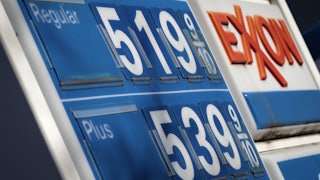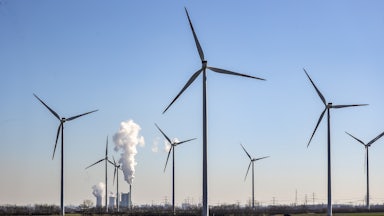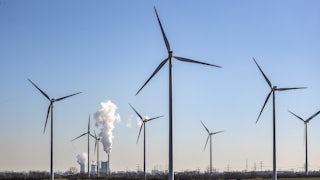There aren’t many phrases that can strike fear into the hearts of an oil executive. “Demand destruction” might be one of them.
For the fossil fuel industry, demand destruction—as in destroying demand for their products—tends to refers to what happens when prices get so high that people become unwilling to keep paying for oil and gas. Demand for those fuels has long been thought to be relatively “inelastic,” or fixed, since people need to turn on the lights, heat their homes, and get to work. But amid skyrocketing prices, alternatives are starting to threaten that model. While they’re still only an option for certain consumers, especially in the United States, oil prices hitting $200 per barrel might prompt customers to buy an electric car instead of a gas-guzzler or replace an old boiler with a heat pump.
Demand destruction can also translate into a more pleasant quality of life. Last week, the hardly radical International Energy Agency—a group founded by Henry Kissinger as oil consuming countries’ counterweight to the producers’ alliance OPEC—released a 10-point list of suggestions for cutting oil use in the wake of Russia’s invasion of Ukraine. It used the gentler term “demand restraint” rather than “demand destruction,” leaving open the polluter-friendly possibility that demand could surge back.
The IEA doesn’t just recommend E.V.s—which the White House has put front and center in its climate plans. Plenty of the changes outlined are pretty mundane. Reducing speed limits on highways by at least six miles (10 kilometers) per hour, for instance, could save 290,000 barrels per day of oil from cars, plus 140,000 barrels per day from trucks. Increasing the adoption of electric and hybrid vehicles would reduce demand by about 100,000 barrels per day, the IEA estimates. And some big-ticket items—in terms of reducing fossil fuel use and associated emissions—are the sorts of changes everyone from Green New Dealers to safe streets advocates have been harping on for decades.
Instituting car-free Sundays in cities could save 380,000 barrels per day, the IEA finds. Making public transit cheaper and increasing walking and cycling options could save 330,000 barrels per day in the short term. The list also includes encouraging car pooling, swapping high-speed and night trains for air travel where possible, limiting business travel, and restricting “private cars’ use of roads in large cities to those with even-number plates some weekdays and to those with odd-numbered plates on other weekdays.”
As they reduce dependence on oil, these changes would have obvious climate upsides. The planes, trains, trucks, ships, and automobiles in transportation—91 percent of which are powered by fossil fuels—make up about 28 percent of America’s greenhouse gas emissions, the largest chunk of any sector.
Though the White House has touted the Bipartisan Infrastructure Package as an engine of decarbonization, its outsize spending for highway expansion may well outweigh the climate benefits of its comparatively meager low-carbon line items. Much like an oil pipeline, new highways lock in emissions for decades, inducing demand for new cars to fill them up. To counter such effects, The New York Times recently reported, Colorado has begun requiring municipalities to offset the emissions entailed by new road construction by upping investments in public transit, bike trails, and E.V. chargers, among other emission-saving measures.
Instituting these measures and the shifts the IEA recommends, though, is less a matter of stiff-lipped patriotic wartime sacrifice than making the U.S. a more livable country. Fossil fuel dependence is an obvious security risk, but it also makes most U.S. cities—by global standards—uniquely unnavigable. In famously dense Paris, one recent study found, 85 percent of people live within walking distance of health care and education, compared to just 4 percent of Indianapolis residents. The U.S. fares poorly across walkability metrics. New York City—among this country’s most walkable cities—ranked fiftieth on closeness to schools and health care after high-scorers like Kathmandu and Athens. It’s not just wealthy European capitals that the U.S. is lagging behind. Small city blocks, the Institute for Transportation and Development Policy finds, make it much easier to get around on foot. The leaders on that front are Khartoum, Bogotá, Lima, Karachi, and Tokyo.
Even without taking climate risks into account, business as usual in transportation is outrageously dangerous. Between 17,000 and 20,000 people die a year from the air pollution from the U.S. transportation sector—a figure that’s decreased dramatically as a result of new regulations and subsequent changes at automakers. Cars are killing ever-higher numbers of pedestrians, with projections showing that deaths jumped by 21 percent in 2020. According to the Governors Highway Safety Association, crashes that kill pedestrians have climbed by 46 percent over the last decade. That cars keep getting bigger isn’t helping matters: Roughly three-quarters of new cars are trucks, vans, and SUVs. If SUVs were a country, the IEA has found that it’d be the sixth-largest-emitting country on the planet.
The proliferation of private car transit, the Austrian philosopher André Gorz noted in 1973, was one of the oil industry’s most ingenious innovations:
If people could be induced to travel in cars, they could be sold the fuel necessary to move them. For the first time in history, people would become dependent for their locomotion on a commercial source of energy. There would be as many customers for the oil industry as there were motorists—and since there would be as many motorists as there were families, the entire population would become the oil merchants’ customers. The dream of every capitalist was about to come true. Everyone was going to depend for their daily needs on a commodity that a single industry held as a monopoly.
Years later, the problem has gotten worse—especially in the U.S. The same corporations that have pushed the myth of American energy independence since the 1970s are the ones that have made daily life here utterly dependent on a volatile global commodity, tying the cost someone pays to get to work in Omaha to whether Russia cuts off a pipeline transiting crude oil from Kazakhstan to the Black Sea. Enough!
The nonprofit Climate + Community Project recently released a Green New Deal for Transportation that put some numbers behind what committing to demand destruction could look like in the U.S.: allocating $300 billion to fully electrify publicly owned buses, school buses, cars, trucks, vans, postal vehicles, railroads, sanitation vehicles, and other aspects of the federal fleet by 2030. (Progress on just one of those—postal vehicles—has been depressingly slow, stymied by right-wing Postmaster Louis DeJoy.) Rather than aiming to sub out internal combustion engines for E.V.s on a one-to-one basis, the plan would spend $300 billion on a “Clean Mobility for Clunkers” program, offering drivers credit to trade gas-guzzlers for new and used E.V.s, but also e-bikes, annual transit passes, or some combination of the above. Coupled with this would be a goal to quintuple public transit ridership while “reducing drive-alone commuting share by a third, and reducing per capita vehicle-miles traveled by 25 percent,” CCP researchers write. Ambitiously, the plan would end the use of federal funds for new highway infrastructure, with the exception of “focused opportunities that improve equity.” The plan also calls for $25 billion per year for a decade to fund mass transit.
As the authors note, reducing reliance on private car transport is also a key piece of reducing the supply chain worries that have ensnared much of the global economy as pandemic recoveries have ramped up. The cost of nickel—a key component in E.V.s’ lithium-ion batteries—has skyrocketed in recent weeks. As electrification takes off, the use of such materials will pick up, but transitioning at the same time to greater public transit can keep us from simply swapping one complicated set of geopolitical dependencies for another. In its report, CCP recommends reducing the amount of battery materials extraction in sensitive ecosystems and disadvantaged communities, investing in recycling capacities, as well as subjecting imports of such things “to the highest standards for labor rights, human rights, and Indigenous rights, as well as for environmental sustainability and emissions.”
Transportation’s hardly the only aspect of life in the U.S. that could use a climate-friendly upgrade. Among the IEA’s other recommendations is to work from home more rather than going into the office; it notes car commuters travel an average of 11 miles one way by car, and that over three-quarters of those drivers travel alone. On the same trip, new cars making that journey in the U.S. consume 40 percent more fuel than those sold in Europe.
More ambitiously, a number of countries and businesses have begun experimenting with another emissions-cutting innovation: the four-day workweek. Iceland recently reported “overwhelming success” in its multiyear trial of a four-day workweek. More than 86 percent of the tiny country—population-wise, Iceland is a bit smaller than Cleveland—can or will soon be able to work four days a week, for comparable pay. Looking at the U.K., the think tank Autonomy—which is helping to lead several four-day workweek pilot programs—found that a four-day workweek there would generate equivalent savings to taking 1.3 million cars off the road.
The shortened workweek cuts emissions partly by reducing commuting time but also by reducing energy use from offices. In the heat of summer and dead of winter, not having to keep office buildings at 70 degrees can generate enormous energy savings. Lighting, heating, cooling, and operating appliances in buildings—including commercial and residential properties—account for nearly 40 percent of U.S. emissions. Buildings produce an astounding 70 percent of New York City’s emissions. Massive building upgrades, like New York’s Local Law 97, can both cut down energy use and create tens of thousands of jobs for union workers. There are plenty of knock-on climate and quality of life benefits to shorter working hours, too. Three-day weekends open more time for people to engage in lower-carbon forms of leisure, like rec league sports and dancing.
Absurdly, fossil fuel companies have been broadcasting climate plans that simply make their emissions disappear. Their idea seems to be that sometime well off into the future, technology will be able to neutralize the enormous planet-heating effects of oil, gas, and even coal. This assumes continued ballooning demand for fossil fuels into the future. It also casts decarbonization primarily as a technological problem that can only be solved with the same companies’ own research and engineering expertise. Evidence for that isn’t exactly promising: Exxon, a study from the U.K. think tank Common Wealth recently found, invested just 0.16 percent of its 2021 capital expenditure in such things.
In reality, demand destruction is a core piece of reaching any livable climate target. As fossil fuel companies spend lavishly trying to hide that fact, they’ve also tried to conceal another inconvenient truth: Destroying demand for fossil fuels can be fun.










